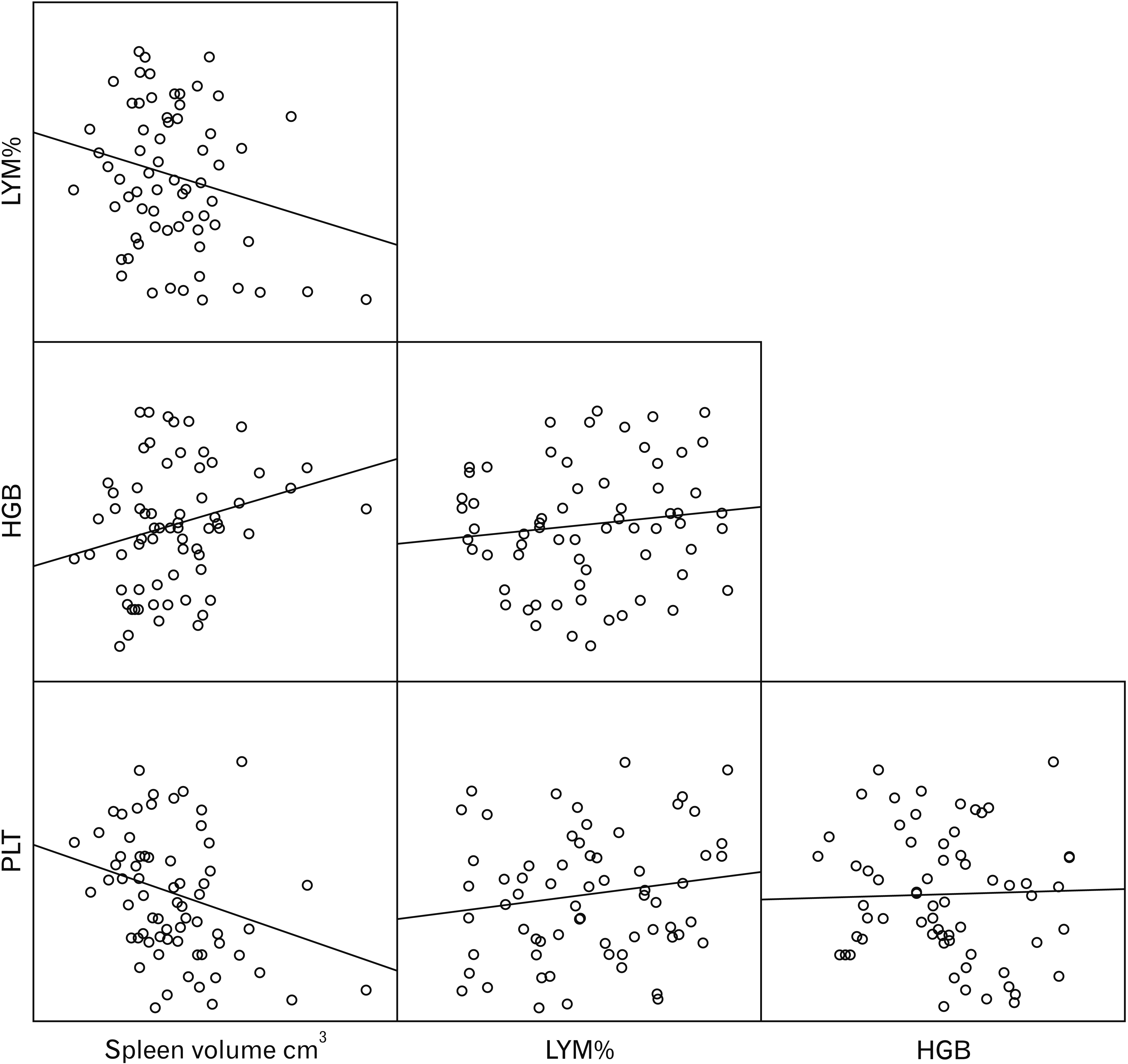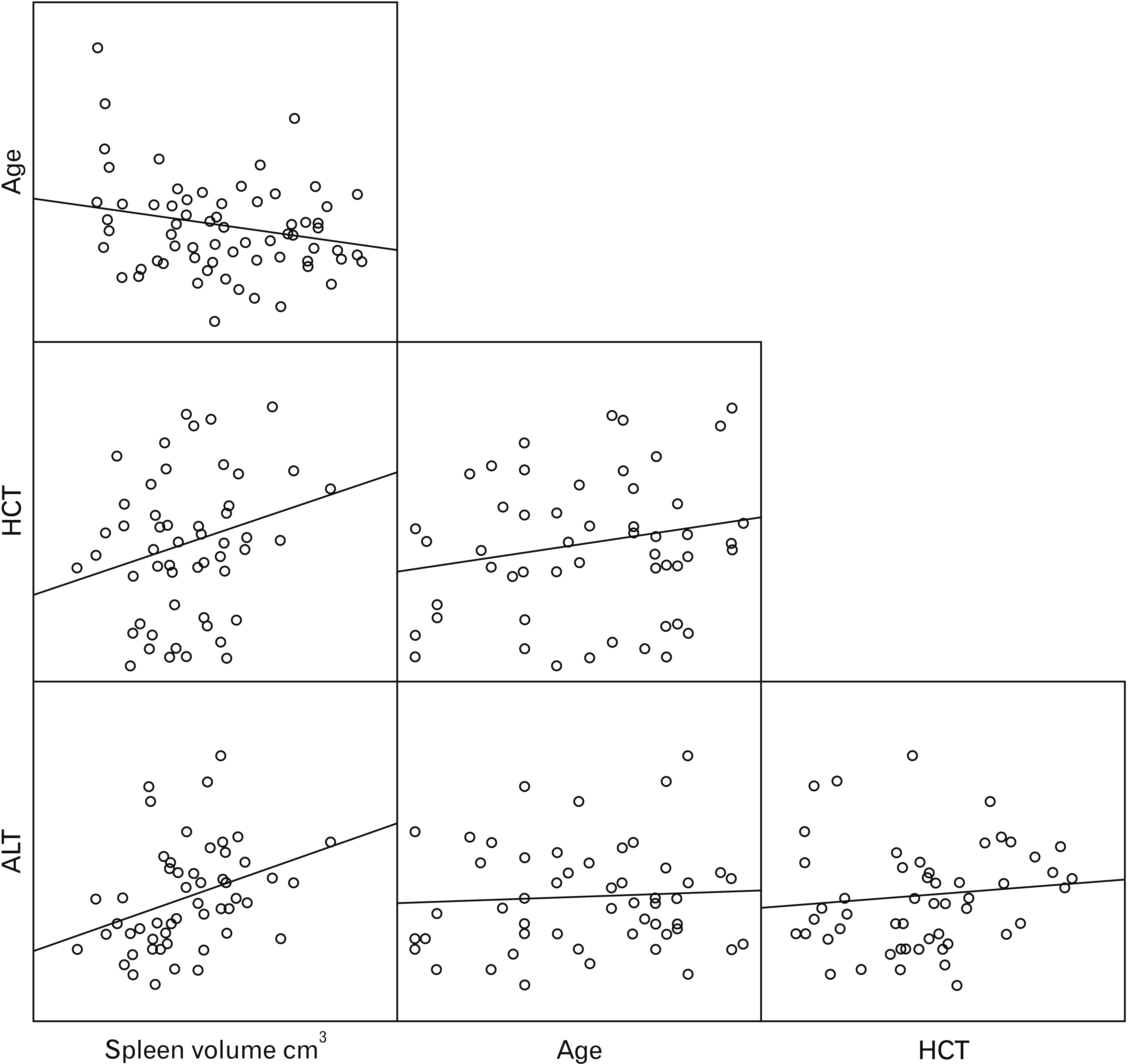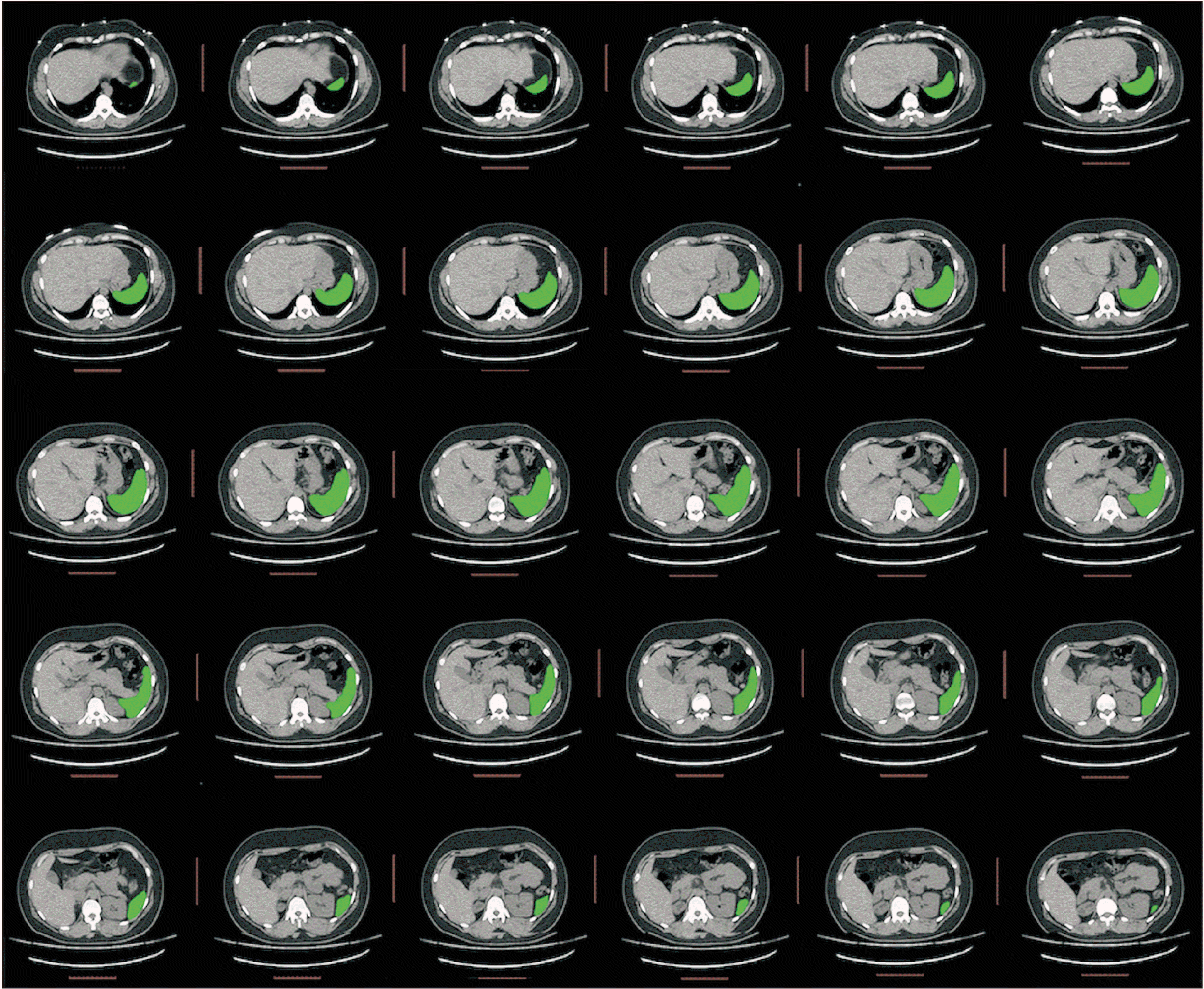4. Adam G, İmamoğlu T, Yaşar F, Erdoğan N. 2010; Estimation of splenic volume in cross-sectonal images by using Cavalieri method: comparison with formula-based calculations. Tepecik Egit Hast Derg. 20:63–9. DOI:
10.5222/terh.2010.84583.

5. Chapman J, Bansal P, Goyal A, Azevedo AM. 2021. Splenomegaly. StatPearls;Treasure Island: DOI:
10.5222/terh.2010.84583.
6. Elmakki E. 2012; Hypersplenism: review article. J Biol Agric Healthc. 2:89–99.
7. Lv Y, Lau WY, Li Y, Deng J, Han X, Gong X, Liu N, Wu H. 2016; Hypersplenism: history and current status. Exp Ther Med. 12:2377–82. DOI:
10.3892/etm.2016.3683. PMID:
27703501. PMCID:
PMC5038876.

9. McCormick PA, Murphy KM. 2000; Splenomegaly, hypersplenism and coagulation abnormalities in liver disease. Baillieres Best Pract Res Clin Gastroenterol. 14:1009–31. DOI:
10.1053/bega.2000.0144. PMID:
11139352.

10. Ishigami M, Ishizu Y, Onishi Y, Kamei H, Kiuchi T, Itoh A, Hirooka Y, Katano Y, Goto H. 2013; Long-term dynamics of hematological data and spleen volume in cirrhotic patients after liver transplantation-various dynamics depending on etiology. Springerplus. 2:374. DOI:
10.1186/2193-1801-2-374. PMID:
24010032. PMCID:
PMC3755816.

11. Medeiros TB, Domingues AL, Luna CF, Lopes EP. 2014; Correlation between platelet count and both liver fibrosis and spleen diameter in patients with schistosomiasis mansoni. Arq Gastroenterol. 51:34–8. DOI:
10.1590/s0004-28032014000100008. PMID:
24760062.

13. Leite LA, Domingues AL, Lopes EP, Ferreira Rde C, Pimenta Ade A Filho, da Fonseca CS, Dos Santos BS, Lima VL. 2013; Relationship between splenomegaly and hematologic findings in patients with hepatosplenic schistosomiasis. Rev Bras Hematol Hemoter. 35:332–6. DOI:
10.5581/1516-8484.20130130. PMID:
24255616. PMCID:
PMC3832313.

15. Singh IK, Bhatnagar V, Gupta AK, Seith A. 2011; Correlation of splenic volume with hematological parameters, splenic vein diameter, portal pressure and grade of varices in extrahepatic portal vein obstruction in children. Pediatr Surg Int. 27:467–71. DOI:
10.1007/s00383-010-2847-3. PMID:
21243364.

16. Toghill PJ, Green S. 1972; The influence of spleen size on the distribution of red cells and plasma. J Clin Pathol. 25:570–3. DOI:
10.1136/jcp.25.7.570. PMID:
5070253. PMCID:
PMC477419.

17. Sahin B, Emirzeoglu M, Uzun A, Incesu L, Bek Y, Bilgic S, Kaplan S. 2003; Unbiased estimation of the liver volume by the Cavalieri principle using magnetic resonance images. Eur J Radiol. 47:164–70. DOI:
10.1016/s0720-048x(02)00152-3. PMID:
12880999.

18. Sahin B, Ergur H. 2006; Assessment of the optimum section thickness for the estimation of liver volume using magnetic resonance images: a stereological gold standard study. Eur J Radiol. 57:96–101. DOI:
10.1016/j.ejrad.2005.07.006. PMID:
16112829.

19. Odaci E, Sahin B, Sonmez OF, Kaplan S, Bas O, Bilgic S, Bek Y, Ergür H. 2003; Rapid estimation of the vertebral body volume: a combination of the Cavalieri principle and computed tomography images. Eur J Radiol. 48:316–26. DOI:
10.1016/s0720-048x(03)00077-9. PMID:
14652153.

20. Clatterbuck RE, Sipos EP. 1997; The efficient calculation of neurosurgically relevant volumes from computed tomographic scans using Cavalieri's direct estimator. Neurosurgery. 40:339–42. discussion 343

21. Sahin B, Aslan H, Unal B, Canan S, Bilgic S, Kaplan S, Tumkaya L. 2001; Brain volumes of the lamb, rat and bird do not show hemispheric asymmetry: a stereological study. Image Anal Stereol. 20:9–13. DOI:
10.5566/ias.v20.p9-13.

23. Caglar V, Alkoc OA, Uygur R, Serdaroglu O, Ozen OA. 2014; Determination of normal splenic volume in relation to age, gender and body habitus: a stereological study on computed tomography. Folia Morphol (Warsz). 73:331–8. DOI:
10.5603/fm.2014.0038. PMID:
25465038.

24. Harris A, Kamishima T, Hao HY, Kato F, Omatsu T, Onodera Y, Terae S, Shirato H. 2010; Splenic volume measurements on computed tomography utilizing automatically contouring software and its relationship with age, gender, and anthropometric parameters. Eur J Radiol. 75:e97–101. DOI:
10.1016/j.ejrad.2009.08.013. PMID:
19775843.

25. Kaneko J, Sugawara Y, Matsui Y, Ohkubo T, Makuuchi M. 2002; Normal splenic volume in adults by computed tomography. Hepatogastroenterology. 49:1726–7. PMID:
12397778.
26. Geraghty EM, Boone JM, McGahan JP, Jain K. 2004; Normal organ volume assessment from abdominal CT. Abdom Imaging. 29:482–90. DOI:
10.1007/s00261-003-0139-2. PMID:
15024516.

27. Martins RN, Cleva Rd, Gouveia ÉM, Ghosn NB, Herman P. 2010; Correlation between splenomegaly and thrombocytopenia in hepatosplenic schistosomiasis. Arq Bras Cir Dig. 23:254–8.
28. Ohira M, Ishifuro M, Ide K, Irei T, Tashiro H, Itamoto T, Ito K, Chayama K, Asahara T, Ohdan H. 2009; Significant correlation between spleen volume and thrombocytopenia in liver transplant patients: a concept for predicting persistent thrombocytopenia. Liver Transpl. 15:208–15. DOI:
10.1002/lt.21663. PMID:
19177451.

29. Vasconcellos LS, Petroianu A, Romeiro JR, Tavares Junior WC, Resende V. 2018; Correlation between the values of circulating blood elements with the size of spleen in the presence of schistosomal splenomegaly. Acta Cir Bras. 33:1103–9. DOI:
10.1590/s0102-865020180120000008. PMID:
30624516.

30. El-Khishen MA, Henderson JM, Millikan WJ Jr, Kutner MH, Warren WD. 1985; Splenectomy is contraindicated for thrombocytopenia secondary to portal hypertension. Surg Gynecol Obstet. 160:233–8. PMID:
3975794.
31. Toros AB, Gokcay S, Cetin G, Ar MC, Karagoz Y, Kesici B. 2013; Portal hypertension and myeloproliferative neoplasms: a relationship revealed. ISRN Hematol. 2013:673781. DOI:
10.1155/2013/673781. PMID:
24159391. PMCID:
PMC3789477.

32. Yonal I, Sargin F. 2015; Polycythemia vera: update on pathogenesis, diagnosis and management. J Ist Faculty Med. 78:83–91.
33. Liesz A, Hagmann S, Zschoche C, Adamek J, Zhou W, Sun L, Hug A, Zorn M, Dalpke A, Nawroth P, Veltkamp R. 2009; The spectrum of systemic immune alterations after murine focal ischemia: immunodepression versus immunomodulation. Stroke. 40:2849–58. DOI:
10.1161/STROKEAHA.109.549618. PMID:
19443795.

34. Dellenback RJ, Usami S, Chien S, Gregersen MI. 1969; Effect of splenectomy on blood picture, blood volume, and plasma proteins in beagles. Am J Physiol. 217:891–7. DOI:
10.1152/ajplegacy.1969.217.3.891. PMID:
5807717.

35. Schlesinger AE, Hildebolt CF, Siegel MJ, Pilgrim TK. 1994; Splenic volume in children: simplified estimation at CT. Radiology. 193:578–80. DOI:
10.1148/radiology.193.2.7972783. PMID:
7972783.

36. Bezerra AS, D'Ippolito G, Faintuch S, Szejnfeld J, Ahmed M. 2005; Determination of splenomegaly by CT: is there a place for a single measurement? AJR Am J Roentgenol. 184:1510–3. DOI:
10.2214/ajr.184.5.01841510. PMID:
15855107.







 PDF
PDF Citation
Citation Print
Print




 XML Download
XML Download